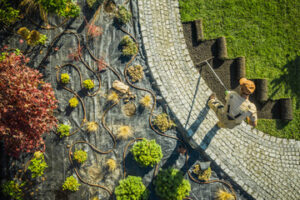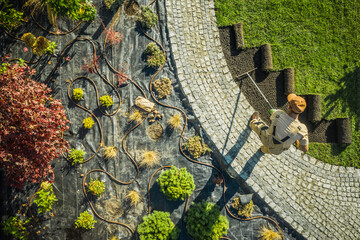Having the right landscape design is essential to your home’s overall appearance and function. It also helps boost resale value.

A good landscape design balances repetition and new elements to keep your garden looking fresh and interesting. It also takes into account scale and pacing. Contact Landscaping Greensboro NC for professional help.
Sod and turf are two popular options for lawns, each with their own distinct set of advantages and disadvantages. Sod is pre-grown grass that is installed onto your property to provide instant results and a lush, beautiful landscape. It requires less maintenance than starting a yard from seed, but it still needs to be properly watered and cared for to thrive.
Turf is a synthetic grass that is made of synthetic fibers that mimic the appearance of natural grass. It has gained popularity in recent years because it is durable and requires little to no maintenance. It is more expensive than sod, but it can last up to 20 times longer.
Whether you prefer the look of sod or turf, you can be sure to impress guests and neighbors with your manicured landscaping. The beauty and charm of your landscape can make a lasting impression, and it’s important to keep your landscaping healthy and vibrant with regular maintenance services.
A lush, green lawn is a great way to add curb appeal and increase your home’s value. It’s also a great place for kids and pets to play, and it provides a soft cushion that helps prevent injuries. Having a lawn that is well-maintained can help keep your yard looking its best and can even improve the air quality on your property.
Sod is an environmentally friendly alternative to planting grass seeds. It eliminates the need for chemical fertilizers and pesticides, which can be harmful to the environment. However, sod does need to be watered regularly, especially during hotter summer and winter climates. It’s also a good idea to avoid heavy foot traffic on new sod until it has established roots. Sod can be installed at any time of year, but spring and fall are ideal seasons for sod installation because they offer optimal conditions for successful root growth.
Landscaping Design
Landscape design is a process of planning the hardscape and softscape features of a property in order to achieve aesthetic and functional goals. This is achieved through the application of principles and elements of design such as scale, pacing, repetition, unity, proportion and rhythm. To develop a landscape design it is important to consider the needs and desires of the client and the site conditions. A landscape designer can assist in this process by evaluating the existing plant material, observing how sunlight falls on different areas of the yard and providing a variety of options that can be implemented over time.
There are many factors that can influence a landscape design such as regional and cultural influences. For example, a Mediterranean style with terra-cotta tiles and vibrant colors is a common choice for clients from warmer climates while a Zen garden style may appeal to clients from Japan. Another influential factor is the level of maintenance desired. Some clients prefer to have low-maintenance landscapes while others are looking for a space that requires more frequent care and attention.
A landscape design can also include the use of water features, lighting and other elements that add to the enjoyment of the space. Oftentimes, a landscape design will be completed using a series of sketches and plans that show how the yard will be laid out. Once a design is approved by the client the landscape designer will provide a detailed master plan or blueprint for the project. This will include the layout of hardscape and softscape materials, planting and horticultural specifications and construction details. The blueprint will be scaled to size and may include computer rendered images for a visual representation of how the final product will look.
Lines are an important element in any landscape design as they create shapes and movement. Straight lines create a formal character and are associated with symmetrical balance, whereas curved lines have more of a natural feel and are associated with asymmetrical balance. Other lines, such as diagonal lines, add a sense of motion and can be used to focus attention on a focal point.
Installation
Landscaping involves creating or enhancing outdoor areas, adding value and function to residential or commercial properties. It ranges from the simple planting of trees and shrubs to the construction of retaining walls, patios, or water features. It can include the addition of decorative rocks, woods, and mulch to improve aesthetic appeal and to protect soil erosion. It also includes regular trimming, mowing, and watering to keep plants healthy and thriving. Landscaping can be done in a variety of styles, including natural landscapes with native plants, formal designs with trimmed hedges, and modern layouts that emphasize functionality and clean lines.
Landscaping services can be performed on new or existing lawns and garden beds. A professional can help determine the best use of space in a yard, assess its drainage and erosion issues, and address any other problems such as soil compaction or poor air circulation. They can also install lawn care equipment, conduct soil testing to measure nutrient levels and pH, and create the proper irrigation system for the site.
Residential landscaping is often used to increase the curb appeal of a home and provide a comfortable area for family gatherings and entertaining friends. Experts can help plan and implement a variety of features, including walkways, fences, and water elements to suit the homeowner’s needs. They can also help to create functional outdoor living spaces, such as patios and fire pits.
Landscapers can also add interest and beauty to a property by creating focal points, using layers, and incorporating colors and textures. They can also add value to a home by selecting plants that are suited for the climate and increasing its energy efficiency through the strategic placement of trees and shrubs.
To get started, it’s important to think about the goals of a landscaping project and what is realistically possible within your budget. Be sure to consider ongoing maintenance costs as well as initial installation fees. It’s also a good idea to establish a timeline for the project. This will help to ensure that all work is completed in a timely manner and that your landscape is in tip-top shape before the warmer weather arrives.
Maintenance
Landscaping is more than planting trees, shrubs, and flowers; it’s also about maintaining the aesthetics and functionality of outdoor areas. A well-maintained landscape adds value to your property and creates a relaxing place for you and your family to enjoy the outdoors.
Maintaining your landscaping requires a variety of services, from pruning and fertilizing to lawn mowing and edging. Some tasks are seasonal, while others are more routine. A professional landscaper will be able to help you develop a maintenance plan that fits your needs and schedule.
A healthy, lush lawn is the foundation of any beautiful landscape. It’s essential to select plants that are suited to your climate and soil conditions, and to establish a proper watering regimen. Proper mowing techniques help prevent damage to the grass and promote growth, while mulching helps retain moisture and suppress weeds.
Another crucial component of landscape maintenance is pest control. Insects and other unwanted visitors can quickly detract from the beauty of your yard, so regular treatment is necessary to keep them under control. Landscaping professionals are trained to recognize and identify common problems, such as disease, nutrient deficiencies, and insect infestation. They can then take the appropriate steps to minimize or eliminate these issues before they become serious problems.
Landscapers also provide various hardscape and softscape services to enhance the visual appeal of your outdoor space. For example, a garden looks more polished when it’s framed by stone pathways, wooden fences, or decorative mulch. And a home or business looks more inviting when its entryway is decorated with attractive planters and benches.
In addition to these features, landscapers can also install and maintain outdoor lighting, ponds, and waterfalls. They can also create retaining walls to control erosion and improve drainage, as well as install outdoor furniture, gazebos, and fire pits. By combining these elements, landscapers can transform your backyard into a picturesque outdoor oasis.
